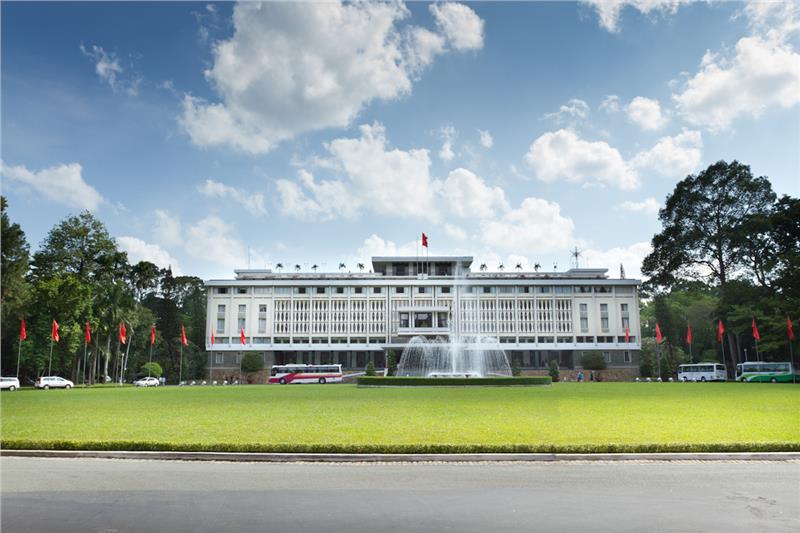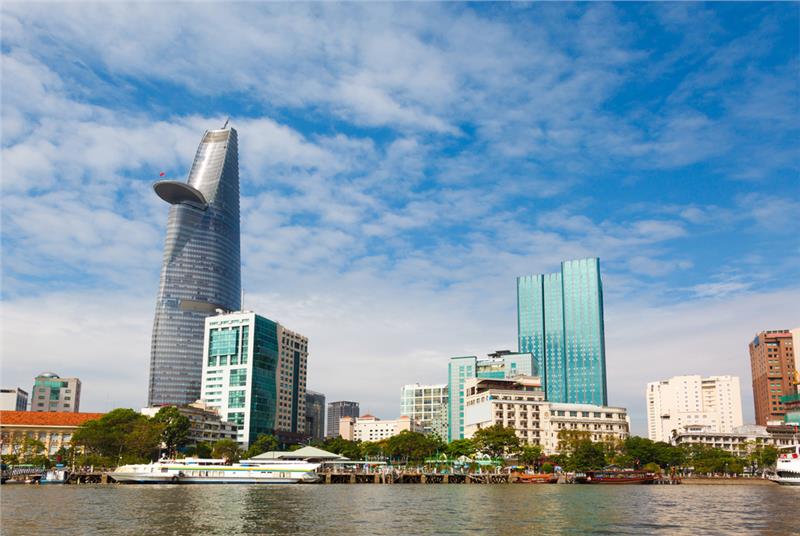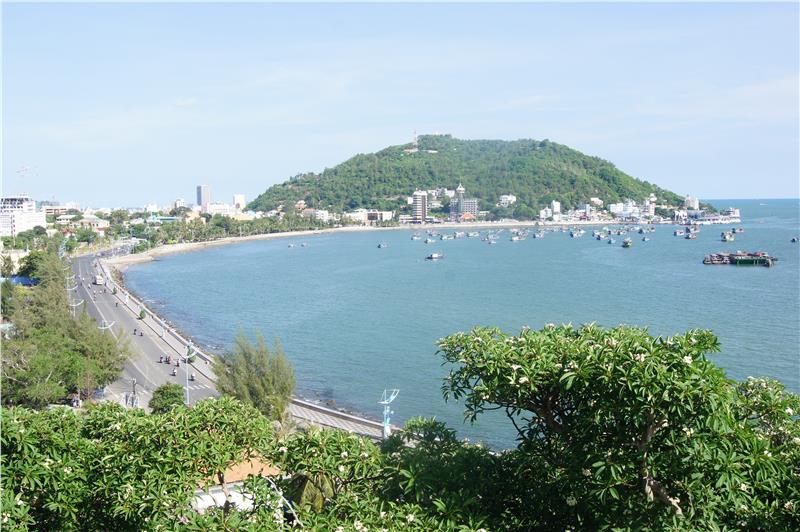The Southeast is situated in a special position which plays an important role in socio-economic development, transportation, and national security. The land also has favorable conditions to develop industries, services, tourism and become a leader in the industrialization and modernization, especially the development of high technology industry, electronic industry, and telecommunication services and so on.
Population: 15192, 3 people
Area: 23, 605 km2

The Southeast of Vietnam consists of 6 provinces including Ho Chi Minh City, Tay Ninh, Binh Phuoc, Binh Duong, Ba Ria – Vung Tau and Dong Nai. The natural area of this land is 23, 605 square kilometer, which accounts for 7.1 % the total area of Vietnam. This is a new land in the developing history of the country. The west and southwest of the region share a border with the Mekong Delta, which has a great potential for agriculture and also the largest granary in Vietnam. The Southeast also borders with the South China Sea in the east and southeast having rich marine resources and favorable conditions for the construction of seaports. In addition, the northwest shares border with Cambodia, which contains Tay Ninh border gate to promote widespread exchanges with Cambodia, Thailand, Laos and Myanmar. With these favorable conditions in the Southeast Vietnam geography, this region becomes an important transport hub not only for the south provinces of the country but also for foreign countries. Besides, belonging to the southern climate, the region has features of equatorial climate with high temperature and virtually no changes in a year. Especially, it has the profound seasonal differentiation consistent with the operation of the monsoon.

As other regions, the Southeast Vietnam history witnessed many wars protecting the country sovereignty of the local people. Under the domination of the South Vietnam, officially known as the Republic of Vietnam governing the southern half of Vietnam until 1975, this region included 13 provinces (Do Thanh Sai Gon, Gia Dinh, Tay Ninh, Binh Duong, Binh Long, Binh Phuoc, Phuoc Thanh, Hau Nghia, Bien Hoa, Long Khanh, Phuoc Tuy, Binh Tuy, and Long An). Being underwent many changes, since 1997, the Southeast of Vietnam consists of one municipality and five provinces.
The Southeast Vietnam administration includes one municipality, Ho Chi Minh City, and 5 provinces including Tay Ninh, Binh Phuoc, Binh Duong, Ba Ria – Vung Tau and Dong Nai. The municipality is divided into urban districts, which are divided into wards. On the other hand, each province will be divided in smaller units consisting of provincial cities, district – level towns, and districts. The smallest unit of one province is commune – level administration unit. In general, politics in Southeast Vietnam in particular and in the country in general is relatively stable. It can be hardly seen demonstrations and riots happening in this land.
According to General Statistics Office in 2012, the Southeast Vietnam population is 15192 with the population density of 644 people per one square kilometer. The flows of immigrants from other places make this land have the highest population growth rate in the country. In terms of demographic, Kinh people account for the majority of the population. Besides, the Southeast also has many different ethnic minority groups, specifically, over 36 groups including Tay, Cham, Muong, Dao, Mnong, Thai, Nung, Khmer, and so on. Because of the dynamic economic development, the region has attracted large brain resources including highly skilled workers, engineers, scientist and entrepreneurs. Besides, the characters of people here are quite different from other regions. They are more generous and sociable and not like the binding. In business, they have adventurous spirit, strive, creative and agility with new things.

The Southeast Vietnam culture is pretty diverse, colorful and has variation by different regions. In terms of religion, being recognized as a multi-ethnic region, the Southeast is an intersection of many religious beliefs from the north and central of Vietnam. This land is also a birthplace of many new religions. Except from other religions like Buddhism, Taoism, Confucianism, and Christianity, Cao Dai religion, which was newly formed basing on these above ones, is one of the biggest religions in this area. Tay Ninh is the Mecca of Cao Dai religion having the largest members in the country. In addition, like the other places, pagodas and temples have presence in almost plains and hills in the South East. In fact, many people in Southeast do not follow any religions; however, they still prefer to go to pagodas (temples) to pray for good things happening to them and their family on the first and fifteenth day of each month.
As mentioned before, the region has over 36 ethnic groups; therefore, it also has diverse languages. Nonetheless, the majority of the population is Kinh people; hence, Kinh language (official language of Vietnam, also called Vietnamese language) is most popular langue in Southeast Vietnam. The special thing in the language of the Southeast people is that they have their distinct dialects. Some sounds and vocabularies are being change in comparison with the official language. For instance, the sounds “d”, “v”, “gi” and “z” in Vietnamese are often pronounced in the same way by the Southeast people. For them, there is not a clear distinction between these sounds. And what’s more, they have a sweet and gentler voice with rhythmic intonation which cannot be misunderstood with other voices of people in the north or central of Vietnam. Besides, each ethnic group has its own language as well.

The Southeast Vietnam economy has the most significant development compared with other regions. This land has been always the country’s leading area in terms of export, FDI, GDP as well as other economic factors. In 1998, Ho Chi Minh City, Binh Duong, Ba Ria – Vung Tau and Dong Nai were listed in the key economic zones by Vietnam Government. These four places are called the Key Economic Quadrangle of the South East. In some later years, Tay Ninh was also added in this area. Although this zone accounts a small area section of area in the whole country, its contribution is quite large and always a crucial factor promoting economic and social growth of the whole country.
Being recognized as an important transport hub of other provinces and countries is a great condition for the Southeast to develop economics and co-operation. Besides, a great deal of educational, scientific and technological institutions, economic centers, industrial zones, and developing urban systems are located here. These features are favorable conditions for promoting services and industries in this land. And what’s more, the Southeast has advantages in industrial plants (rubber, coffee, tea, cashew, mulberry, peanuts, soybeans, rush, cane, and fruit trees with the high economic value) and aquaculture, livestock and fishing.
Society in Southeast Vietnam differentiates by region. The life of people living in the big cities like Ho Chi Minh or Vung Tau is wealthier in terms of both finance and emotions compared to other region in the country. They also have higher education and better medical services as well. In a family, women and men have equal rights. On the other hand, residents in ethnic groups have more difficult lives. Many of them still live in poor condition and do not have chances to approach education, medical services and so on. Some ethnic minority families follow patriarchy while the others are matriarchy.
Tourism

In general, the Southeast was newly formed and developed over 300 years, but the land has full elements of promoting tourism including cultural relics, traditional history, intangible and tangible cultural heritages, traditional villages, festivals, and traditional folks, etc.
As described as the Pearl of the Far East, Ho Chi Minh City has many historical relics and ancient architectures such as Nha Rong Wharf, Cu Chi Tunnels, Independence Palace, City Hall, Municipal Theater, and City Post Office… Besides, this beautiful city also has a system of ancient temples like Notre-Dame Cathedral, Giac Lam, Ba Thien Hau, To Dinh Giac Vien … and War Remnant museums including Ho Chi Minh City Museum, Museum of Vietnamese History, the Revolution Museum, etc. Recently, the city continues to implement long-term investments in tourism. Some of the most attractive entertaining areas built to serve the needs of tourists are Saigon Zoo, Botanical Gardens, Suoi Tien Amusement and Culture Park, Dam Sen Tourist and Cultural Park, and Can Gio’s Eco beach resort.
Ba Ria Vung Tau tourism is outstanding for its beautiful beaches as well as many lakes and thermal springs. Some well-known tourist places are Con Dao Island, Ho Coc Beaches, Binh Chau Hot Spring, Niet Ban Monastery, Linh Son Pagoda, and Bach Dinh vestige.
Binh Phuoc has many potential landscapes and vestiges like Mo Waterfall, Ba Ra Mountain, Bu Gia Map National Park, Bombo Village, etc. Binh Duong tourist destinations include Hoi Khanh Pagoda, Binh An Lake, Pottery Village, Tuong Binh Hiep Lacquer Village, Chau Thoi Mountain Pagoda, Lai Thieu Orchards…
Dong Nai is located in the center of the South East. Although this land do not have the advantage of tourism resources like Vung Tau or luxurious attractions as the Pearl of the Far East, this land still has its own strengths to attract tourists such as Nam Cat Tien Forest, Vinh Cuu Natural Reserve, Tri An Hydropower, Chua Chan Mountain, …
With a plenty of natural and historical tourism resources, the Southeast Vietnam tourism promises to bring tourists wonderful and memorable trips.
Festivals

With over 36 ethnic groups, the Southeast Vietnam festivals are also quite diverse. Each group will have its own festivals to make the folk festivals in the land become more various and colorful. However, there are three main types of festival here.
Village’s Tutelary God Worshiping Festival
Tutelary God is considered as a hero of one village who found against foreign invaders or reclaimed a new land. Every time people in a village want to celebrate something or organize something important, they often hold Village’s Tutelary God Worshiping Festival first. The festival is often taken place on Tet Holidays on spring or in some important day of villages or the country. The meaning of the festival is to help local people to express the gratitude to their ancestor and pray for good things happening to the village. There are many traditional activities will be held in the festival including rituals of procession, incense offering, and rejoicing games, etc.
Nghinh Ong Festival (Whale Worshipping Festival)
This is the largest festival of fishing villages in the South East. The festival is held when a fishing season begins. Ong is a respectful name that fishermen address whales and dolphins, which they believe to be guardian spirits. Activities in the festivals often include the rites of Ong worshipping, procession of Ong on sea by a decorated boat with flag and flowers, and bustling with drums and gongs.
Goddess Festival (Mother Goddess Festival)
Goddess Festival in the Southeast includes Ba Ngu Hanh festival, Nghinh Co festival, Thien Hau Thanh Mau festival … In the belief of Vietnam community, worshipping goddess is quite common and originated deep roots from matriarchy, in which a mother holds an important position in the family.
